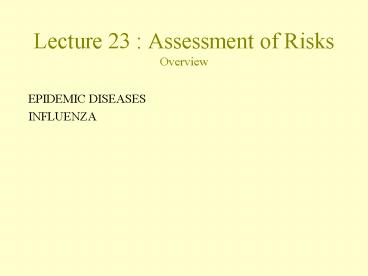Lecture 23 : Assessment of Risks Overview - PowerPoint PPT Presentation
1 / 9
Title:
Lecture 23 : Assessment of Risks Overview
Description:
Lecture 23 : Assessment of Risks Overview EPIDEMIC DISEASES INFLUENZA Epidemic Diseases History shows that new diseases arriving as an epidemic can have a devastating ... – PowerPoint PPT presentation
Number of Views:164
Avg rating:3.0/5.0
Title: Lecture 23 : Assessment of Risks Overview
1
Lecture 23 Assessment of Risks Overview
- EPIDEMIC DISEASES
- INFLUENZA
2
Epidemic Diseases
- History shows that new diseases arriving as an
epidemic can have a devastating impact. - New diseases are being discovered every year.
- The threat posed by these new diseases is related
to their means of transmission. - Diseases spread by person to person contact pose
a risk, but they are generally containable. - Water- and food-borne infections can be contained
with adequate public health measures. - Vector-borne diseases are dependent on the
availability of vectors. It is becoming more
difficult to control vectors. - Air-borne diseases pose the greatest threat.
3
Influenza(1)
- Biggest threat may be influenza.
- Influenza viruses are classified into A, B and C
strains. The A strain is further classified by
its haemagglutinin and neuraminidase antigens,
which mutate. - 1957 Asian flu was A2 or H2N2, 1968 Hong Kong flu
was A3 or H3N2. - Influenza is found in birds, pigs and horses.
- The 1918 Spanish flu killed between 20 million
and 100 million people worldwide. - SARS in 2003 was initially thought to be a flu.
4
(No Transcript)
5
Asiam Palm Civet
6
Influenza(2)
- Avian flu H5N1 infected people in Vietnam in
2004. - Similar to the H5N1 strain in the Hong Kong
outbreak in 1998, which was contained by culling
the entire chicken population. - Human cases low, and at present confined to
people in close contact with chickens. - Big fear is it could mutate into a human-human
airborne infection. - Effective vaccines may not be deployed for six
months. - With 63 per cent mortality, fear may cause all
essential services to grind to a standstill.
7
(No Transcript)
8
H5N1 Influenza Deaths (Birds and Humans)
9
The End































